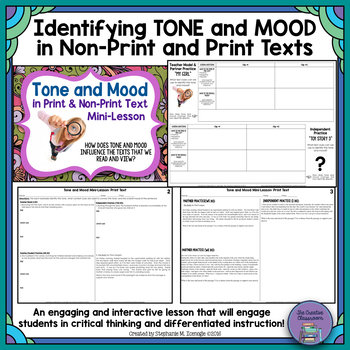Tone and Mood Activities - Tone and Mood in Non-Print and Print Texts
- Zip
What educators are saying
Description
Are you looking for a a great mini lesson to introduce your students to tone and mood or how about an intervention for students who are struggling to identify tone and mood in text? This engaging and interactive lesson will not only get your students thinking critically and working collaboratively, but it will also teach them an essential skill that will help them better understand more complex texts. Students will interact with both non-print and print texts to help them learn how to identify tone and mood. Students will LOVE that they get to watch entertaining video clips and that they get multiple chances to show what they know. Teachers will LOVE that this resource includes everything needed to implement this activity, including differentiated materials and the ability to customize this lesson to better suit the needs of their individual students.
☞ The following instructional materials are included in this product:
• Tone and Mood Worksheets: Students will use the PQNS graphic organizer and other scaffolded organizers to guide them through the direct instruction portion of this lesson. These materials will be used as reference materials during the partner practice and independent practice portions of this lesson. Students will view video clips from different movies to analyze the tone and mood of each clip and determine how the tone and mood influenced the way the films are portrayed. For the print text activities, there are differentiated materials available. One option contains shorter text situations that students will use to analyze tone and mood while the other option contain more complex excerpts that will challenge on level or advanced students.
• Tone and Mood Presentation (EDITABLE Slides included): This presentation contains all the important information for this lesson that will help guide teacher and students through this lesson. There are 19 completed slides that require no changes whatsoever to implement the lesson; however, there are 20 pre-designed slides and blank templates included that allows teachers to customize the lesson to better fit the specific needs of your classroom.
• Tone and Mood Links Handout: This handout contain links to video that you can use to introduce tone and mood to students. Don't have access to video or you would rather your students read an informational text to gain their new learning? There are links to informational texts resources that you can use too! The links to the video clips for the non-print text are also included.
Please be sure to download the preview file to see exactly what you are getting when you purchase this product!
Created by Stephanie Harpole, The Creative Classroom © 2016
All rights reserved by author.
Permission to copy for single classroom use only.
Electronic distribution limited to single classroom use only.
▶️ Connect with The Creative Classroom:
➜ Sign up HERE for The Creative Classroom's EMAIL LIST for exclusive freebies, tips, and more!
➜ BLOG





